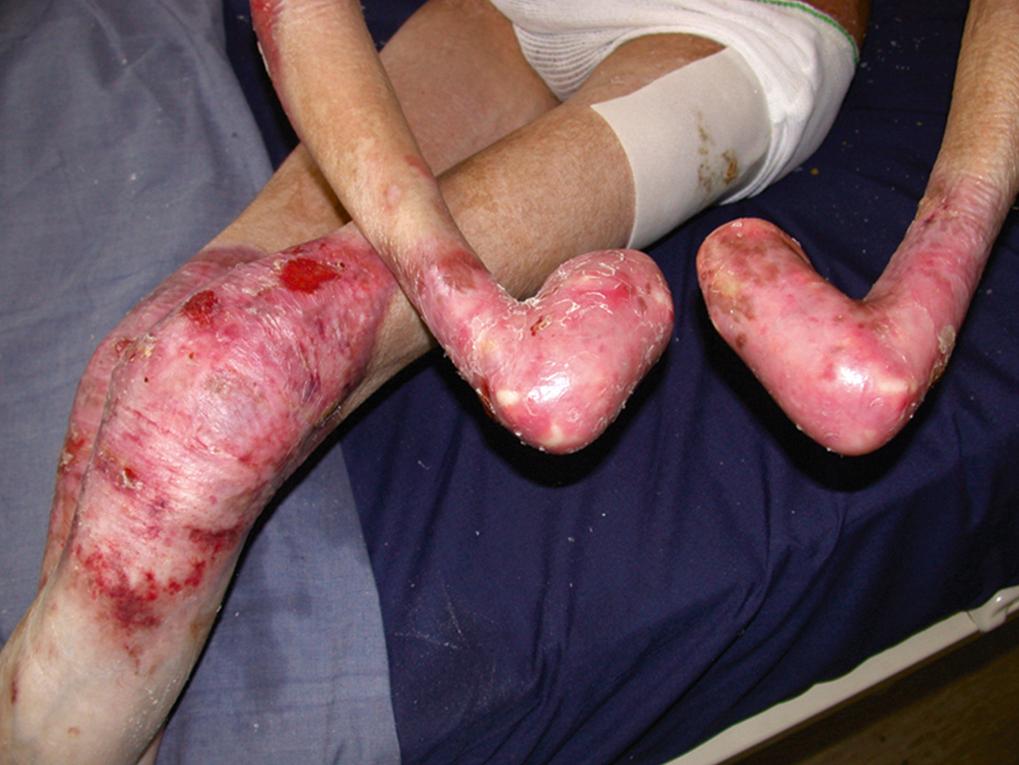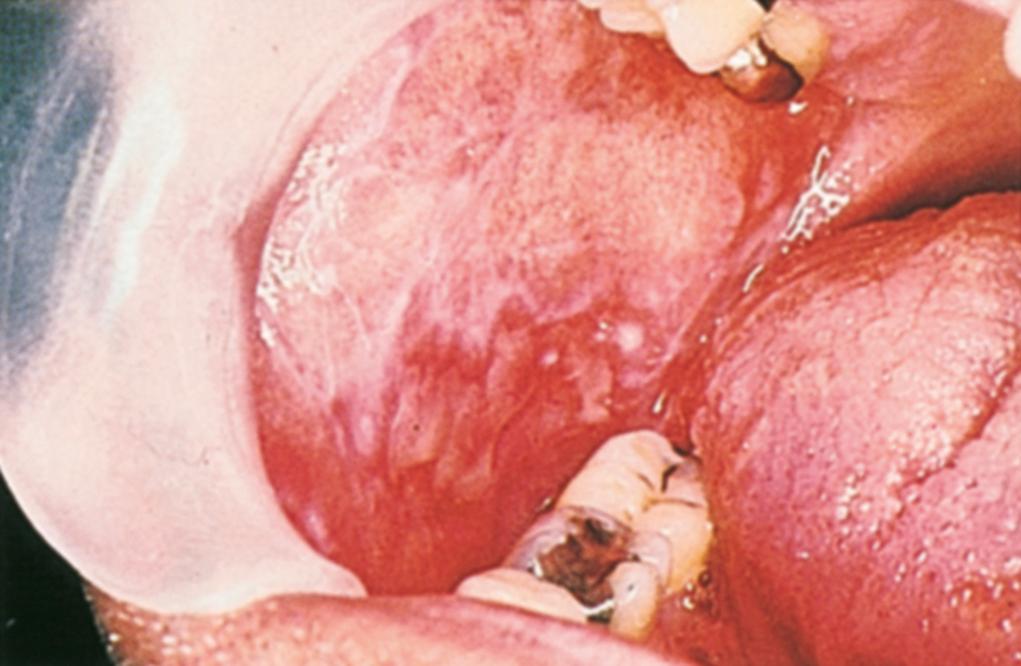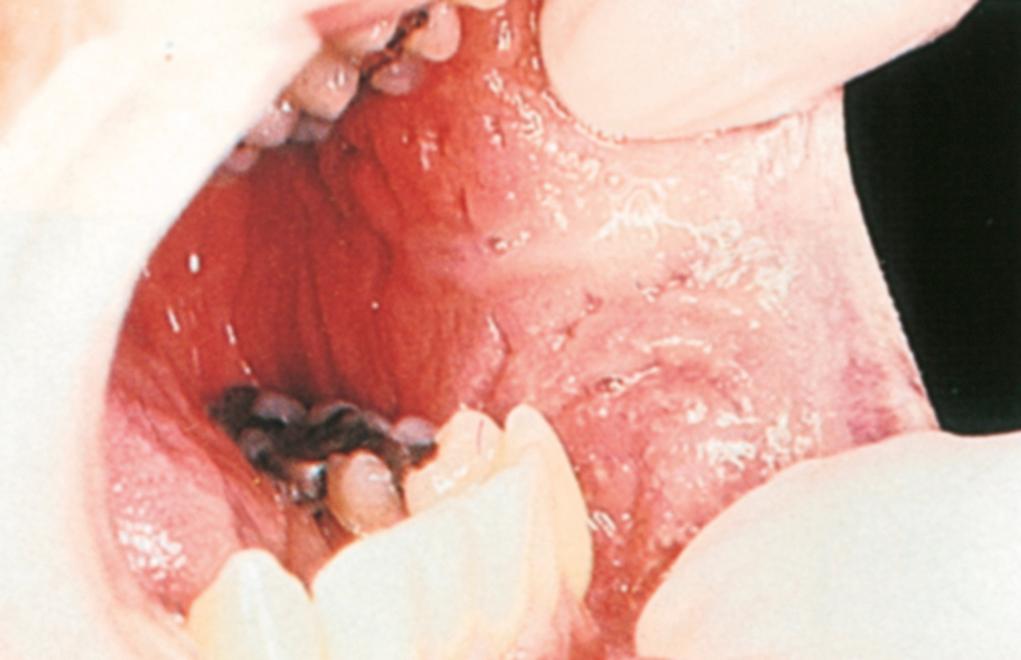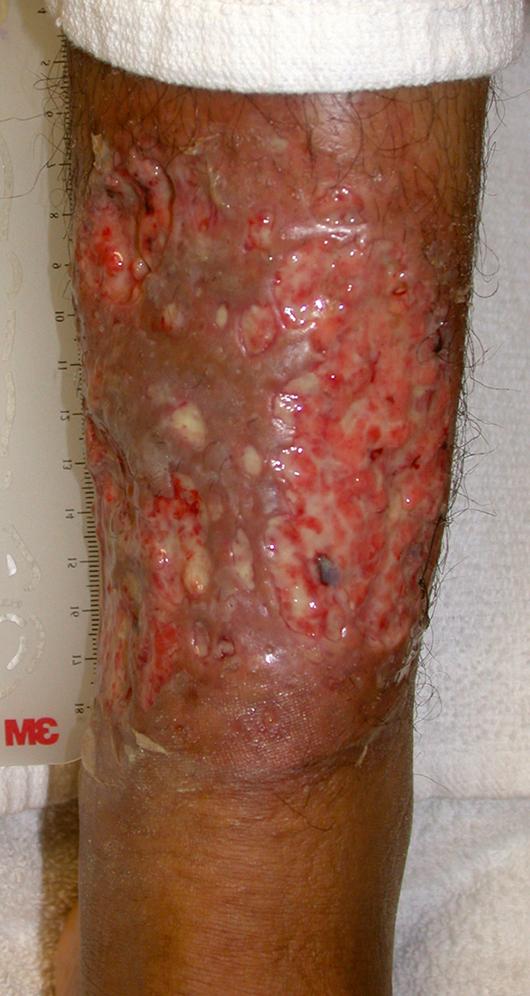Physical Address
304 North Cardinal St.
Dorchester Center, MA 02124
The vesiculobullous skin diseases include pemphigoid, pemphigus, epidermolysis bullosa (EB), erythema multiforme (EM), and the Stevens-Johnsons/toxic epidermolysis spectrum. They may have oral and GI manifestations, as discussed later.
Pemphigoid is a general term for heterogeneous blistering disorders characterized by serum immunoglobulin (Ig)G or IgA autoimmune antibodies directed against 230-kd and 180-kd hemidesmosomal proteins (among other keratinocyte antigens) located at the squamous epithelial basement membrane. This antigen-antibody reaction leads to loss of adhesion between the epithelium and its supportive basement membrane substrate. Pemphigoid clinically presents with tense bullae and ulcers affecting the mucosa of the oral cavity, pharynx, esophagus, anus, conjunctiva, and skin. Oral findings appear as highly inflamed (erythematous) mucosa on the buccal and gingival mucosa.
Two types of pemphigoid have been identified: bullous pemphigoid (autoimmune and drug-induced variants) and cicatricial (mucous membrane) pemphigoid. Patients with bullous pemphigoid typically have skin lesions, and about one third also have mucous membrane lesions. The autoimmune subtype most often presents in the older population and may be preceded by a non-bullous, intensely pruritic, “urticarial” phase of disease. Drug-induced bullous pemphigoid has been associated with thiazide diuretics, antibiotics (e.g., penicillins, vancomycin), NSAIDs, angiotensin-converting enzyme (ACE) inhibitors (e.g., captopril), and possibly angiotensin receptor blockers (ARBs; e.g., valsartan), among many others with less literature support for their causative nature. Discontinuation of a suspected offending agent is primary therapy. In contrast to bullous pemphigoid, all patients with cicatricial pemphigoid have mucosal lesions, and about one third also have skin lesions. Ocular symblepharon (i.e., adhesion between the tarsal and bulbar conjunctiva) commonly occurs with cicatricial pemphigoid. Potentially fatal upper GI bleeding from esophageal involvement by pemphigoid has been reported.
For all types of pemphigoid, immunofluorescent staining of involved mucosa and skin is diagnostic, showing linear deposition of antibody and complement in the basement membrane zone. Patients with elevated serum IgG and IgA autoantibodies are more likely to respond to systemic medications. Treatment ranges from low-dose to high-dose prednisone. Alternative therapies for patients with contraindications to glucocorticoid use or with systemic toxicities from glucocorticoids include dapsone, tetracycline and nicotinamide in combination, azathioprine, chlorambucil, plasma exchange, IVIG, cyclosporine, cyclophosphamide, methotrexate, rituximab, and infliximab.
Pemphigus vulgaris differs from pemphigoid in that the serum autoantibodies are directed against intercellular keratinocyte proteins, causing loss of cell-to-cell adhesion. This antigen-antibody reaction leads to bullous skin lesions, often flaccid, that can be life-threatening if untreated. Oral involvement can be extensive. Mucosal involvement can cause poor nutrition and severe pain. Half of patients with pemphigus vulgaris present with oral lesions, and oral lesions occur in almost 100% of patients during the illness. Direct immunofluorescence of biopsy material is diagnostic, showing IgG antibodies and complement on the surface of squamous epithelial cells. Indirect immunofluorescence detects circulating IgG antibodies in most patients with pemphigus vulgaris. Treatment consists of various regimens of topical or systemic prednisone, sometimes supplemented with cytotoxic or immunosuppressive drugs.
Paraneoplastic pemphigus shares features of pemphigus vulgaris and EM. It is associated with GI malignancies, lymphomas, leukemias, thymomas, and soft tissue sarcomas. Features that characterize paraneoplastic pemphigus include: (1) painful mucosal erosions and a polymorphous skin eruption; (2) intraepidermal acantholysis, keratinocyte necrosis, and vacuolar interface reaction; (3) deposition of IgG and C3 intercellularly and along the epidermal basement membrane zone; (4) serum autoantibodies that bind to skin and mucosa epithelium in a pattern characteristic of pemphigus, as well as binding to simple, columnar, and transitional epithelia; and (5) immunoprecipitation of a complex of 4 proteins (250, 230, 210, and 190 kd) from keratinocytes by the autoantibodies. The prognosis of paraneoplastic pemphigus is generally poor because symptomatic improvement depends on successful treatment of the underlying malignancy.
EB is a heterogeneous group of rare inherited disorders of skin fragility ( Fig. 25.1 ). They are characterized by the formation of blisters with minimal trauma and are divided into dystrophic (scarring), junctional, and simplex forms. Oral erosions, premature caries, and gingival involvement, as well as GI disease, are common in the dystrophic form, but also occur in some patients with the junctional form. In addition to oral erosions, esophageal strictures are the most common GI complication in dystrophic EB. They most commonly occur in the upper third of the esophagus but may also be found in the lower third. The esophageal strictures are probably induced by repeated trauma from food and/or refluxed gastric contents; therefore, strict adherence to a soft food diet remains a mainstay of management. Although dilations with bougienage historically have been shunned because of an unacceptable risk of increasing esophageal stenosis over the long term, evidence supports the use of balloon dilation as a safe and efficacious method of palliating esophageal strictures without this risk. Esophageal resection, feeding gastrostomy, and colonic interpositioning have been effectively used in dystrophic EB patients with severe esophageal strictures. Esophageal webs in the postcricoid area have also been described. Anal stenosis and constipation (with or without stenosis) are frequent in patients with dystrophic EB. Junctional EB has been uniquely associated with pyloric atresia. Anemia and growth retardation frequently develop in patients with severe dystrophic and junctional EB, partly because of GI and oral complications.

Patients with clinical lesions identical to the dystrophic forms of EB but with no family history and an adult onset have been identified; their condition is called acquired EB or EB acquisita (EBA). EBA, like pemphigus and pemphigoid, is an autoimmune disease. The autoantibodies in EBA are directed against type VII collagen. The diagnosis of EBA is established by routine histology and direct immunofluorescence examination of skin biopsy specimens. Like patients with cicatricial pemphigoid, EBA patients may have significant mucosal involvement, especially oral and esophageal disease. Coexistent Crohn disease has been reported in a number of patients with EBA. Treatment is with immunosuppressive agents.
EM is an acute mucocutaneous eruption associated with underlying infections (especially HSV). It is often preceded or accompanied by low-grade fever, malaise, and symptoms suggesting an upper respiratory tract infection. The eruption consists of alternating pink and red target lesions on the elbows, knees, palms, and soles, and of shallow, broad oral erosions. Patients with EM may only have oral involvement. Variable degrees of nonspecific erythema are found, with or without ulcers. Crusting, hemorrhagic, and moist lip ulcers may be present. Severe oral and pharyngeal pain, secondary bacterial and fungal infections, and bleeding are common complications. The diagnosis is made by clinical characteristics, excluding other specifically diagnosable diseases, and by response to treatment. The biopsy reveals a nonspecific interface reaction. Oral EM can be self-limited or chronic, and often the inciting process goes unidentified. Management includes palliative measures and elimination of any offending agent. Often, glucocorticoids and/or other immunosuppressive drugs are needed. Recurrences and flares have variable patterns. Herpes-associated EM lesions are treated with episodic or suppressive antiviral therapy with acyclovir, valacyclovir, famciclovir, or foscarnet.
Stevens-Johnson syndrome (SJS, with between 10% and 30% skin sloughing) and toxic epidermal necrolysis (TEN, with more than 30% skin sloughing) are diagnosed when severe, acute, painful targetoid lesions and skin sloughing occur in association with eye, skin, and mucous membrane involvement. In contrast to EM, which is usually infection related, SJS and TEN are almost always caused by a reaction to a medication, such as an antibiotic (especially a sulfonamide) or an anticonvulsant. Diffuse oral and pharyngeal ulceration may prevent oral intake. At endoscopy, the esophagus may show diffuse erythema, friability, and whitish plaques that can be mistaken for candidiasis. Diffuse gastric and duodenal erythema and friability may be present without esophageal involvement. The colonoscopic appearance may resemble severe ulcerative or pseudomembranous colitis. However, colonic biopsies show extensive necrosis and lymphocytic infiltration, without crypt abscesses or neutrophils. This pattern is reminiscent of graft-versus-host disease (see Chapter 36 ). The mucosa of large portions of bowel may slough in SJS, accounting for reports of hematemesis, melena, and intestinal perforation. Treatment largely consists of discontinuation of offending pharmaceutical agents (often anticonvulsants or antibiotics), hospital admission to a burn unit, if possible, and supportive care by a multiteam approach. No reliable evidence exists for the use of systemic glucocorticoids, intravenous immune globulin, or plasmapheresis in the treatment of SJS/TEN, but weak evidence suggests that cyclosporine may reduce disease progression and mortality when used early in the disease course.
Lichen planus (LP) is a common chronic inflammatory disorder involving the mucosa and skin. The disease usually begins in adulthood, and two thirds of patients are women. Oral lesions are variable in their presentation and may appear as white, lace-like, and/or punctate patterns on any mucosal surface ( Fig. 25.2 ). Mucosal erythema or ulceration is common. Oral lesions may appear as asymptomatic lace-like plaques on the buccal mucosal or as painful erythematous or erosive plaques involving the tongue, buccal mucosa, or gingiva. Topical and/or systemic glucocorticoids are effective in decreasing the signs and symptoms in almost all cases of oral and cutaneous LP. Topical tacrolimus is an effective steroid-sparing treatment alternative. Esophageal LP may present with progressive dysphagia and odynophagia, upper GI bleeding, strictures, and squamous cell carcinoma. The endoscopic findings include erythema, ulcers, proximal esophageal webs, and erosions throughout the esophagus. An increased prevalence of chronic liver disease, including chronic hepatitis C and PBC, has been reported in patients with LP. Oral LP may be associated with an increased risk of squamous cell carcinoma arising in areas of atrophy or erosion, regardless of treatment. Bullous LP may occur with cancer immunotherapy agents that inhibit programmed death-1 (anti-PD).

Both Crohn disease and UC may be accompanied by cutaneous manifestations (see Chapters 115 and 116 ). Skin lesions are more common (up to 44%) and often more specific in Crohn disease than in UC. It is rare for cutaneous involvement by Crohn disease to appear before symptomatic bowel disease. The most common cutaneous complication of Crohn disease is granulomatous inflammation of the perianal or perifistular skin, which occurs by direct extension from underlying diseased bowel. Metastatic Crohn disease refers to rare ulcerative lesions, plaques, or nodules that occur at sites distant from the bowel. Such lesions favor intertriginous areas such as the retroauricular and inframammary regions. On histologic study, local cutaneous extension and metastatic Crohn disease show sarcoid-like granulomatous inflammation, and both occur with greater frequency in patients with colonic involvement by Crohn disease.
Oral manifestations of Crohn disease occur in 4% to 14% of patients and include aphthae, lip fissures, cobblestone plaques, cheilitis, mucosal tags, and perioral erythema. Patients may also complain of metallic dysgeusia. Aphthosis occurs in approximately 5% of patients with Crohn disease, and the lesions are clinically and histologically indistinguishable from typical aphthae. Aphthosis and perianal-perifistular ulcerations are not seen in ulcerative colitis. Granulomatous cheilitis is a rare condition with recurrent lip swelling that leads to enlargement and firmness of the lips. A lip biopsy shows noncaseating granulomas. In rare cases associated with Crohn disease, this condition may be a component of Melkersson-Rosenthal syndrome (scrotal tongue, lip swelling, with or without facial palsy and migraine) or may be idiopathic.
Pyostomatitis vegetans ( Fig. 25.3 ) and its cutaneous counterpart, pyoderma vegetans, is characterized by pustules, erosions, and vegetations involving the labial mucosa of the upper and lower lips, buccal mucosa, and gingival mucosa, as well as the skin of the axillae, genitalia, trunk, and scalp. Both pyostomatitis vegetans and pyoderma vegetans are specific markers of IBD (Crohn and ulcerative colitis) and may precede the GI symptoms by months to years. Histologically, intraepithelial and subepithelial eosinophilic miliary abscesses are characteristic. Superficial pustules coat the friable, erythematous, and eroded mucosa of the oral cavity, least commonly the floor of the mouth and tongue. Symptoms may be severe or minimal. Eosinophilia and anemia are common. Diagnosis is made from biopsy findings, and treatment is with topical or systemic glucocorticoids, dapsone, or sulfasalazine.

Erythema nodosum is a common inflammatory disorder of the subcutaneous fat, with a marked predilection for women. Lesions characteristically appear as 1-cm or larger shiny, tender, deep red nodules on the anterior shins. The pathogenesis is unknown. The causes of erythema nodosum are infections (especially streptococcal, systemic fungal, and tuberculous), medications (especially oral contraceptives), and leukemias. Erythema nodosum develops in 7% of patients with Crohn disease and 4% of patients with ulcerative colitis. In addition, GI infections with Yersinia enterocolitica, Shigella flexneri, and Campylobacter jejuni have been associated with erythema nodosum. Treatment of the underlying disease, strict bed rest, and elevation of the legs, as well as the use of anti-inflammatory drugs or potassium iodide, are effective.
Pyoderma gangrenosum is a noninfectious ulcerative cutaneous disorder of unknown pathogenesis ( Fig. 25.4 ). The classic lesion is a tender or painful ulcer with an elevated, dusky purple border that is widely undermined. One or multiple lesions may occur. Lesions begin as small papulopustules that break down very rapidly. Pathergy, the appearance of new ulcers at sites of minor trauma or surgery, is often present. The diagnosis is one of exclusion, in that infectious and other causes of ulceration, including factitious dermatitis, must be ruled out. Most cases of pyoderma gangrenosum occur in patients with no underlying disease. Pyoderma gangrenosum develops in approximately 5% of patients with UC and 1% of patients with Crohn disease. The bowel disease may be subclinical when the skin lesions appear, and therefore bowel evaluation, especially of the rectum and distal colon, is essential in cases of pyoderma gangrenosum. If the disorder is associated with underlying bowel disease, therapy of the bowel disease may lead to improvement of the skin lesions. The usual management of pyoderma gangrenosum includes local wound care, high-dose systemic glucocorticoids, or steroid-sparing immunosuppressive agents, such as azathioprine, mycophenolate mofetil, methotrexate, and cyclosporine.

Become a Clinical Tree membership for Full access and enjoy Unlimited articles
If you are a member. Log in here